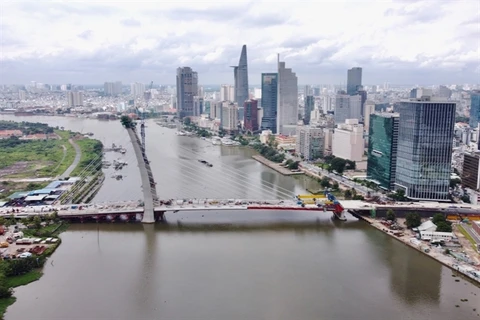 A man shops for rice in a supermarket. Experts believe agricultural output will keep pace with domestic demand, keeping prices stable. (Photo plo.vn)
A man shops for rice in a supermarket. Experts believe agricultural output will keep pace with domestic demand, keeping prices stable. (Photo plo.vn) Nguyen Ba Minh, head of the Institute of Economics and Finance, is relatively optimistic about short-term inflation.
He held that the unpredictability of the Russia-Ukraine conflict and the COVID-19 pandemic would add uncertainty to the world’s economy, slowing down its recovery pace and driving down global material prices.
The situation would be better back home as agricultural output is expected to keep pace with domestic demand. As farm produce weighs heavily on the Consumer Price Index (CPI), their supply-demand balance would result in inflationary stability.
Another favourable factor is Vietnam’s inflation-focused monetary policies, which had proved to be highly effective against volatile prices.
“All factors considered, I think the inflation target of 4% is plausible. I estimate annual CPI growth at around 3.3 to 3.9% this year,” he said.
Le Quoc Phuong, former deputy director of the Commercial and Industrial Information Centre under the Ministry of Industry and Trade, asserted that the world's economy would definitely slide into recession in 2022.
He has two scenarios for Vietnam’s economy in the short term amid the global downturn.
Under the first scenario, the recession will come with falling commodity prices worldwide. Lower global prices, coupled with an abundant domestic food supply, will give the country much room for inflation control. The target of 4% is within reach.
Under the second scenario, global prices will continue to increase steadily, resulting in FED's benchmark hikes. The restrictive stance on interest rates will weigh on exchange rates, causing a pass-through effect on domestic prices. The target of 4% will be less likely.
The former deputy director suggested the coordination of flexible monetary policies and fiscal policies and more tax cuts on fuels to curb inflation in case the second scenario unfolds.
Ngo Tri Long, former head of the Ministry of Finance (MoF)'s Price Research Institute, underscored three major factors behind inflationary pressures in Việt Nam in the second half of 2022.
First, Vietnamese economy has high trade openness and is largely dependent on imported materials. Mounting material prices in the world thus would translate into domestic prices.
Second, rising fuel prices, undoubtedly, would add to production bills, lifting inflation.
Third, the stimulus package of 350 trillion VND takes root, causing a big shift in aggregate demand. High demand will cause upward pressure on price levels.
He forecast that domestic inflation would overshoot the target by around 0.5% by year-end.
Nguyen Xuan Dinh, deputy head of the MoF's General Policy Office, remarked that soaring prices had become the order of the day in many countries. Notably, inflation hit 8.6% in the US, whereas the figure was 9% in the EU.
Meanwhile, core inflation was kept at just 1.25% in Vietnam in the first six months of 2022.
Amid inflationary pressures from overseas, he called for active and flexible monetary policy to keep inflation in check for the rest of the year.
He urged the authorities to come up with a sufficient supply of essential commodities to avoid shortages, ensuring price stability.
Finally, he suggested the use of price-stabilising funds and tax cuts to ease domestic fuel prices, a large contributor to rising inflation.
Nguyen Manh Hung, chairman of the Vietnam Consumers Protection Association, was concerned that the CPI growth of 2.44% in the first half of 2022 was too good to be true.
"We've found a discrepancy between the actual price growth and the reported figure of 2.44%. Food prices rose in many localities but the report said the opposite," he said.
The chairman was relatively uncertain about future, saying that the Russia-Ukraine conflict would continue leading to price fluctuations./.
VNA

























